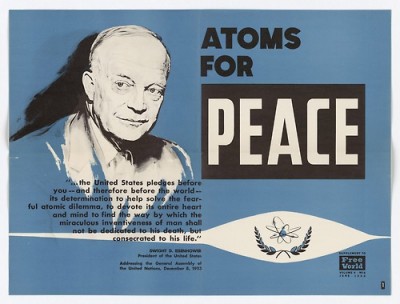Atoms For Peace And Iran Nuclear Talk: The Theatrics Continues – From Eisenhower to Obama

“Much of what passes today for diplomacy is not diplomacy at all; its propaganda … We are trying to use diplomacy for a task for which it has never been designed: propaganda and psychological warfare.” – Theodore Sands
On December 8, 1953, President Eisenhower delivered a speech to the UN that was described as ‘a splendid piece of political theater’. President Eisenhower, Lewis L. Strauss, C.D. Jackson and John Foster Dulles worked on the final draft of the speech on a plane home from the Bermuda conference. Jackson had even kept the plane circling so that the finished document could be handed to the press as soon as they landed[i].
The speech was intended to make the atom ‘friendly’ and highlight its peaceful benefits, though it had a far more sinister intent. The speech was intended to counter the Soviet peace initiative. Washington was fearful that Moscow’s cooperation and its propensity for peace would underscore Washington’s baseless accusations that had painted the Soviet Union as the greatest threat to the world. With the Soviet peace initiative, Washington would risk losing reluctant allies or neutrals to an unthreatening USSR. The Atoms for Peace speech was intended to invalidate Soviet’s peace initiative[ii].
With this in mind, America proposed that Soviets and Americans contribute fissionable materials to the International Atomic Energy for peaceful uses, was a peace counteroffensive calculated on a Soviets decline. At the same time, the United States needed to appear eager to secure Soviet cooperation so as to place the failure of the negotiations on Soviet intransigence. But the Soviets upped the ante.
In response to the fissile pool, the official Soviet response stressed the “unconditional banning of atom and hydrogen weapons” – in other words, atomic disarmament. The United States found itself in an awkward position. Eisenhower’s speech was not a call to disarmament. It was a counter-peace initiative. In response, it resorted to the monopolization of ‘atoms for peace’ by ensuring that the U.S. would be the first to establish nuclear presence in various countries that would make them dependent on the U.S. for every aspect of the nuclear program from design, construction, initial operation, educational material and so forth.
In this vein, Iran’s nuclear program was initiated under the former Shah of Iran. For as long as the Shah was a poster boy for General Electric nuclear reactors, America encouraged Iran’s civilian nuclear program. In fact, in 1975, according to National Security Decision Memorandum 292, the United States gave permission [emphasis added] for “U. S. material to be fabricated into fuel in Iran for use in its own reactors and for pass-through to third countries with whom we have Agreements. “
All changed with the Iranian revolution that ousted the Shah. In other words, the United States appointed itself interpreter and executioner of international laws and treaties, doling out favors to ‘allies’ and punishing nations that valued sovereignty. Iran was punished, and painted as a threat for pursuing its rights within the framework of international law and the NPT.
President Obama opted for ‘diplomacy’ taking a leaf from Eisenhower’s book. Disguising propaganda and psychological warfare as diplomacy, he feigned an interest in ‘negotiating’ Iran’s nuclear program as discussed with AIPAC. During his presidential campaign in 2008, he reassured AIPAC of his intentions, stating:
“Our willingness to pursue diplomacy will make it easier to join our cause. If Iran fails to change course when presented with this choice by the United States it will be clear to the people of Iran and to the world that the Iranian regime is the author of its own isolation and that will strengthen our hand with Russia and China as we insist on stronger sanctions in the Security Council.” (See Geneva 3, Iran Nuclear Negotiations for Dummies).
In spite of the numerous obstacles placed in its path, Iran has demonstrated to the world that it wishes to pursue peace and transparency. It exercised ‘heroic flexibility’ to cooperate with the P5+1 and consistently and tirelessly demonstrated its goodwill, transparency, and cooperation. But as with the Eisenhower era, Iran’s cooperation has demonstrated to the world that it is not a threat. Its peaceful agenda is the greatest threat to Washington’s agenda.
For 34 years, Washington has been engaged in covert and overt operation to overthrow the government of the Iranian people. It has been complicit in war and war crimes. It has violated bilateral treaties, international laws, and even customary laws. For decades, Washington has demonized Iran in order to persuade friend and foe to forgo billions of dollars in trade and profit. Its fear mongering has enabled it to recycle petrodollars and its expansion. It has even committed acts of terror and has supported terrorism with the justification that Iran is the threat.
In light of Iran’s full cooperation, how can Washington explain its actions? How can Washington live in peace? As Sun Tzu said, “Victorious warriors win first and then go to war, while defeated warriors go to war first and then seek to win.”
Soraya Sepahpour-Ulrich is an independent researcher and writer with a focus on U.S. foreign policy and the role of lobby groups in influencing US foreign policy.
Notes:
[i] Cull, Nicholas, “The Cold War and the United States Information Agency (FRUS 1952-1954, Vol. 2, part 2, Memo of discussion at NSC, 30 July 1953, pp. 1184-1185; Memo by Robert Cutler, 10 September 1953; Chronology, Atoms for Peace project, 30 September 1954).

